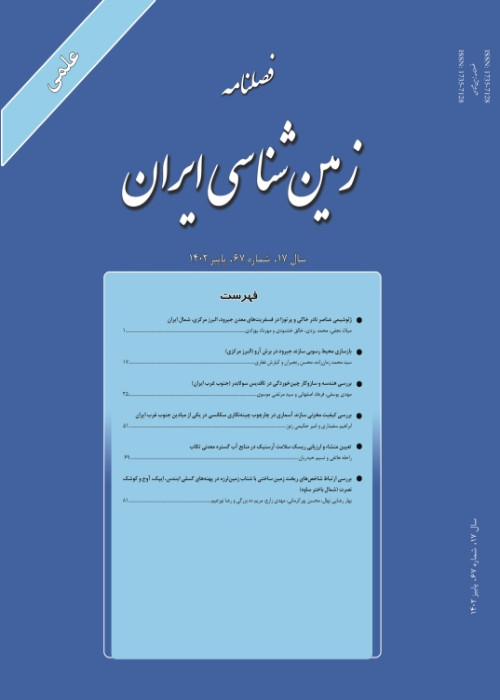Biostratigraphy of Khan and Jamal formations in Kalmard, Shotori and Shirgesht regions (central Iran) based on Foraminiferas (Fusulinid)
Author(s):
Arefi Fards. , Adabi , M.H. , Khosrotehrani , Kh. , Aghanabatia. , Shemirania. , Davidov , V.I
Abstract:
To understand microfaunas (age) of Permian rocks in Kalmard, Shotori and Shirgesht areas, nine stratigraphic sections were measured and studied. The Permian succession in Kalmard area, which are known as the Khan Formation, is mainly composed of siliciclastic-carbonate sequences with high siliciclactic components. In this study, the identified fusulinid assemblage of the Khan Formation shows the Sakmarian age. Comparative studies of this assemblage with fusulinid fauna from other regions such as central Pamir, South of Afghanistan and Ruteg (South Tibet), Karakorum and Hindu Kush show that the fusulinid assemblages of the Khan Formation can be assigned to the Peri-Gondwana area of the Tethys. After deposition of the Khan Formation, the sea regressed and the Kalmard area was a site of erosion from Yaktashian through Late Permian. The laterite deposits confirm this epirogeny. Marine condition did not return to this area until the Early Triassic time. The Permian strata in Shotori and Shirgesht areas are named Jamal Formation. The major part of the Jamal Formation in Shotori and Shirgesht areas consists of carbonate deposits. The identification of fusulinid faunas in lower and middle parts of the Jamal Formation in Shotori area show Kubergandian-Early Midian age. No identifiable fusulinid were found in the upper part of this formation and only small percentage of Permian smaller foraminiferas was present in the second section in Shotori, indicating that the upper part of Jamal Formation is Early Dzhulfian in age. The best stratigraphic section of Jamal Formation is exposed in Bagh-e-Vang mountain in Shirgesht area. The basal part of Jamal Formation is named Bagh-e-Vang Member. The comprehensive study of fusulinids and smaller foraminiferas in the Bagh-e-Vang section indicates a Yakhtashian-Bolorian age for the Bagh-e-Vang Member and a Kubergandian-Early Dzhulfian age for the rest of the section. The fusulinid assemblages in Jamal Formation is characteristic of the Peri-Tethys (with warm water condition). As mentioned above, the fusulinid fauna in Khan Formtion is similar to that of Peri-Gondwana (with cool water condition). These differences between fusulinid assemblages in these two areas suggests that Tabas and Kalmard areas were separated during Permian, however during Early Triassic they were located in the same geographic latitudes. This conclusion is confirmed by similar lithological and paleontological evidences in Kalmard and Tabas areas throughout Triassic time.
Language:
Persian
Published:
Iranian Journal of Geology, Volume:2 Issue: 4, 2006
Page:
3
magiran.com/p747413
دانلود و مطالعه متن این مقاله با یکی از روشهای زیر امکان پذیر است:
اشتراک شخصی
با عضویت و پرداخت آنلاین حق اشتراک یکساله به مبلغ 1,390,000ريال میتوانید 70 عنوان مطلب دانلود کنید!
اشتراک سازمانی
به کتابخانه دانشگاه یا محل کار خود پیشنهاد کنید تا اشتراک سازمانی این پایگاه را برای دسترسی نامحدود همه کاربران به متن مطالب تهیه نمایند!
توجه!
- حق عضویت دریافتی صرف حمایت از نشریات عضو و نگهداری، تکمیل و توسعه مگیران میشود.
- پرداخت حق اشتراک و دانلود مقالات اجازه بازنشر آن در سایر رسانههای چاپی و دیجیتال را به کاربر نمیدهد.
In order to view content subscription is required
Personal subscription
Subscribe magiran.com for 70 € euros via PayPal and download 70 articles during a year.
Organization subscription
Please contact us to subscribe your university or library for unlimited access!


